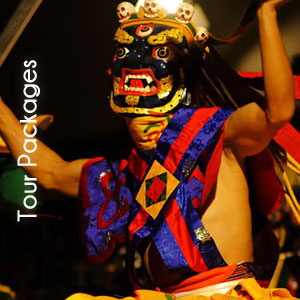Besides others that Bhutan can offer to the world, is its pristine environment that is almost intact. Our ecosystem is rich and diverse, because of its location, great geographical and climatic variations. Bhutan’s high, rugged mountains and valleys boast of spectacular biodiversity, earning it a name as one of the world’s ten most important biodiversity hotspots.
Recognizing the importance of environment, conservation of its rich biodiversity is one of its development paradigms. The government has assured of maintaining 60% of its forest resources for all times to come through the recently enacted law passed by the National Assembly. As of today, about 65% of the total land area is under forest cover and about 26% of the land area fall under the protected area. The protected area comprises of four parks that is designated as home for the wild life sanctuaries.
National Parks and Wildlife Sanctuaries
Each of Bhutan’s National Parks and Wildlife Sanctuaries is an essential part of the Bhutan Biological Conservation Complex – a system of national parks, protected areas and forest corridors covering 35 percent of the country. Each of these parks and sanctuaries has its own special character and are homes to endangered animals, birds and plants.
Jigme Singye Wangchuck National Park
Located in the central part of the country, Jigme Singye Wangchuck National Park covers 1,300 sq.km and is the second largest protected area of Bhutan. The natural habitats in the park range from high permanent ice peaks to low conifer and broadleaf forests. The park was formally known as the Black Mountain National Park. The varying altitude and rainfall in the areas have created a wide diversity of climatic conditions, making it a suitable home for many species of plants, animals and birds.
The park has one of the highest coverage of mature fir, pine and other types of broadleaf forests making it one of the last largest undisturbed tracks of forest in the Eastern Himalayan region. Both musk deer and Himalayan black bear can be found here. The golden langur that is endemic to Bhutan, the rare clouded leopard, the red panda and the Royal Bengal tiger are also found in the park. This National Park is an important link between the northern and southern tiger population in Bhutan. The eastern side of the park supports about 20% of Bhutan’s tiger population.
The national park is also home to 391 bird species of which seven species are among the globally threatened species. Phobjikha valley, in the buffer zone of the park, is the winter habitat of the black necked cranes. More than 260 cranes winter in Phobjikha every year.
TrumshingLa National Park
Situated at the very heart of the nation and covering 768 sq. km, ThrumshingLa National Park is Bhutan’s newest National Park, officially gazetted in July 1998. Pristine forests ranging from alpine to subtropical broadleaf combine with dramatic mountains, snow leopards, tigers, red pandas and rare plants to create a globally important and unique habitat.
With its elevation ranging from less than 1,000 m to more than 4,000 m, and temperatures between – 21? C and 28? C, the park has some of the most diverse climatic variations and habitats in the world. The park made news in the year 2000 when a WWF-supported survey team captured a camera-trap image of a tiger at 3,000 meters – the first photographic evidence that the magnificent creatures exist at such high altitudes. Besides that, the park has 341 species of birds making it truly a birdwatcher’s paradise.
ThrumshingLa National Park has some of the most breathtaking scenery and natural habitats in the world. It is a source of awe and inspiration for numerous tourists and trekkers and tourism helps to sustain the lives of the communities within the park. With an effective management plan, dedicated park staff and WWF support, it should stay that way for generations to come.
Royal Manas National Park
Bhutan’s Crown Jewel, the Manas National Park represents the largest example of tropical and sub-tropical ecosystems in Bhutan. With its thousands of animal and plant species, many globally endangered, it is not only the most diverse protected area in the Kingdom but also one of the world’s biologically outstanding sites.
Lying in south central Bhutan, Manas is connected at the southern border with India’s Manas Tiger Reserve, a World Heritage Site. To the north it borders the Jigme Singye Wangchuck National Park. Royal Manas was designated a wildlife sanctuary in 1966 making it Bhutan’s oldest protected area. The area was upgraded to a National Park in 1993.
There are wide climate variations in Royal Manas. The May-September monsoons bring up to 5,000mm of rain. Rainfall is negligible in winter and the climate is extremely pleasant from November till February.
Manas is also extremely rich in wildlife species, including the highly endangered Royal Bengal tiger, Asian elephant, greater one-horned rhinoceros, clouded leopard, Himalayan black bear, gangetic dolphin and pangolin. Found virtually nowhere else in the world is the especially rare golden langur, a primate of extraordinary grace and beauty with its long, silky blond fur.
More than 365 species of birds have been officially recorded in Royal Manas National Park with an additional 200 believed to be in residence. Species found here include the globally threatened rufous-necked hornbill, Pallas fishing eagle, great white-bellied heron, spotted wren-babbler, blue-headed rock thrush and emerald cuckoo. Many of the park’s more than 900 types of plants have commercial, medicinal, traditional and religious significance.
WWF and Bhutan’s Nature Conservation Division jointly developed a five-year conservation management plan for this very special haven on earth. The plan includes training and equipping park staff, improving park infrastructure, and supporting biological and socio-economic surveys and park monitoring programmes.
Jigme Dorji National Park
With an area of 4,349 sq. km, the Jigme Dorji National Park is the largest protected area in Bhutan. It is one of the most biologically rich areas in the Eastern Himalayan region, and stretches from warm broad-leaved forests to permanent ice fields and glaciers on Bhutan’s north-western border. The monsoon rains and a varied topographical gradient, from just over 1,000 meters to more than 7,000 meters above sea level, account for this rich plant and animal diversity.
Sacred peaks such as Jomolhari, Tsherimgang and Jichu Drakey are prominent landmarks in the park. Glaciers and glacial lakes are interspersed in the mountains forming important head waters for some of Bhutan’s main rivers.
The alpine region houses numerous flowers such as the national flower blue poppy, edelweiss, orchids, rhododendrons etc.
Charismatic animal species like the snow leopard, takin, tiger, black bears and red panda inhabit the forests and mountains of the park. This may be the only place in the world where the Royal Bengal tiger and snow leopard habitats overlap. Most of Bhutan’s most popular trekking routes can be found inside the Jigme Dorji National Park.
Bumdeling Wildlife Sanctuary
Bumdeling Wildlife Sanctuary is located in north-western part of Bhutan covering an area of 1,545 sq. km with 420 sq. km of buffer zone encompassing parts of Trashi Yangtse, Lhuentshe, and Mongar district. It shares international borders with the Tibetan region of China in the north and India in the north east. The sanctuary is home to around 100 species of mammals, including globally endangered species such as snow leopard, Royal Bengal tiger and red panda.
About 150 black necked cranes spend their winter in Bumdeling every year from mid November to early March. Bumdeling Wildlife Sanctuary is also a paradise for butterflies: as of now 130 species are recorded and another 120 are expected to be found there. Besides natural beauty and diversity many significant religious and cultural places can be found inside the sanctuary, such as Rigsum Gompa, the mystic Singye Dzong and Dechenphodrang Lhaghang– maybe most scenic monastery in the whole country.
Sakteng Wildlife Sanctuary
Located in the easternmost part of the Kingdom, Sakteng Wildlife Sanctuary spans an area of 650 sq. km and is Bhutan’s newest protected area (launched in 2003). The sanctuary is a lost world of biodiversity waiting to be discovered. It presents a wide diversity of Himalayan terrestrial ecosystems, namely alpine meadow, temperate forest, and warm broadleaf forest.
The Sanctuary is home to people of isolated nomadic tribes. It is characterized by thick carpets of rhododendrons, and in its habitat roam snow leopards, red pandas, Himalayan black bear, barking deer, Himalayan red fox, the hoary-bellied Himalayan squirrel and even the mythical Yeti (or the “Abominable Snowman”). Sakteng is virtually untouched by development. Bird species include the Assamese macaw, blood pheasant, grey backed shrike, grey headed woodpecker, common hoopoe, rufous vented tit and dark breasted rose finch.
Plant life includes Bhutan’s national flower, the blue poppy, rhododendrons, primulas and gentiana, all of which transform the park into a garden of colours during spring time. There are also many plants with medicinal values- such as cordyceps.

Bhutan Travel Info
Bhutan Travel tips, Daily Tourist Tariff, Bhutan Visa Information, Tour payment regarding your tour booking to Bhutan. Click on the link below to know more.
Learn more >>

Tour Packages
Travel to Bhutan with Sachock Bhutan Travels. We, at Sachock offers Cultural tours, Trekking Tours including the World's toughest Trek Snowmen Trek and colorful Festival tours of Bhutan.
Learn more >>

Getting into Bhutan
Travelling to Bhutan can be accessible by Air, to Paro(the only international airport in Bhutan connecting with Indian Cities, Nepal, Bangaldesh, Thailand & Singapore) & Road through Southern border towns of Phuentsholing, Gelephug and Samdrup Jongkhar.
Learn more >>

Sachock Bhutan Travels, P.O Box No: 1304, Karma Khangzang, Thimphu : Bhutan
Phone # (+975) 77177717 / 77210443 : Tele-Fax (+975) 2 333 881
Email: [email protected] / www.SachockBhutanTravels.com
Sachock Bhutan Travels, Copyright © 2025. All Rights Reserved.






